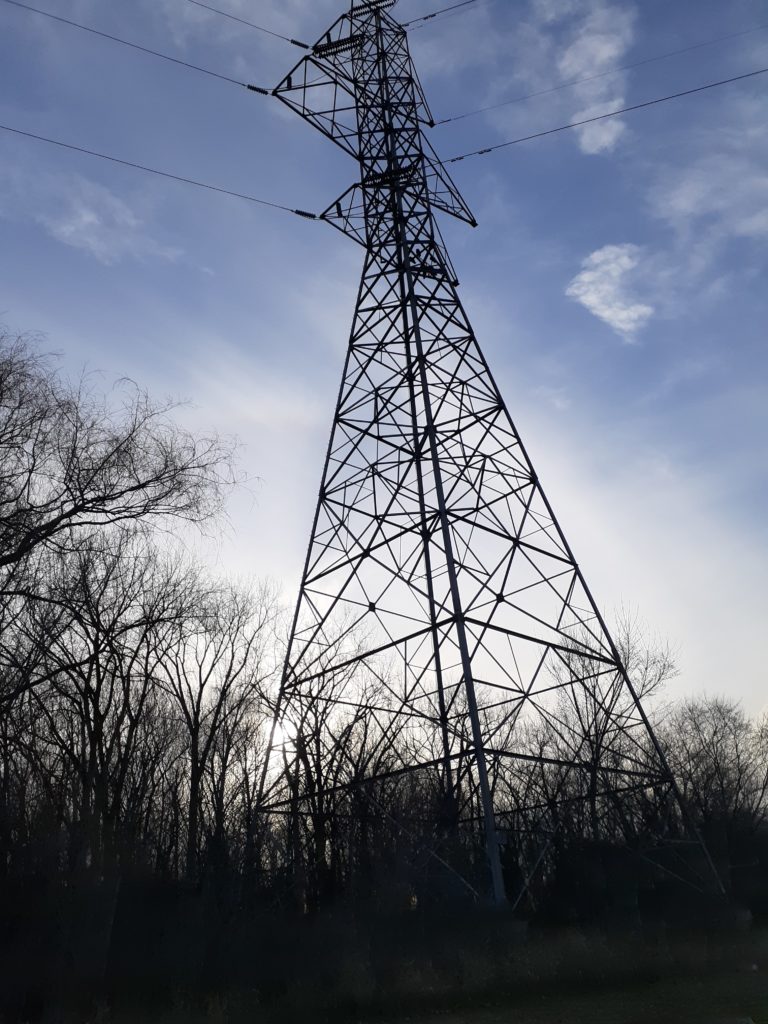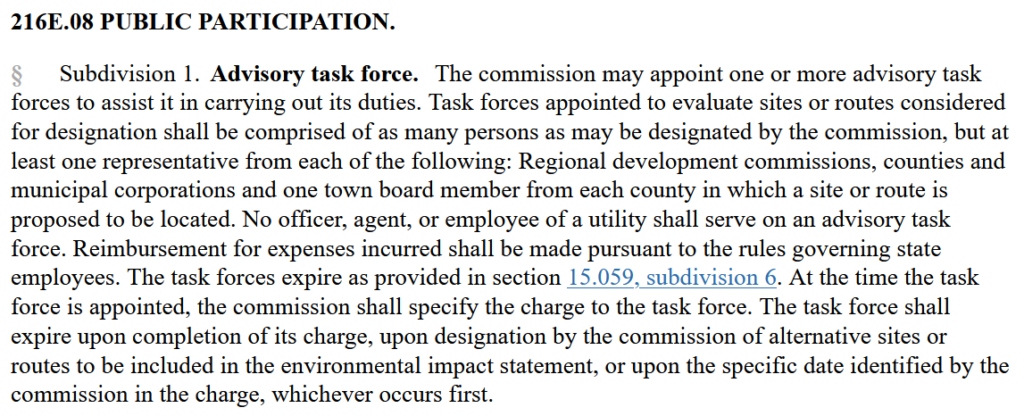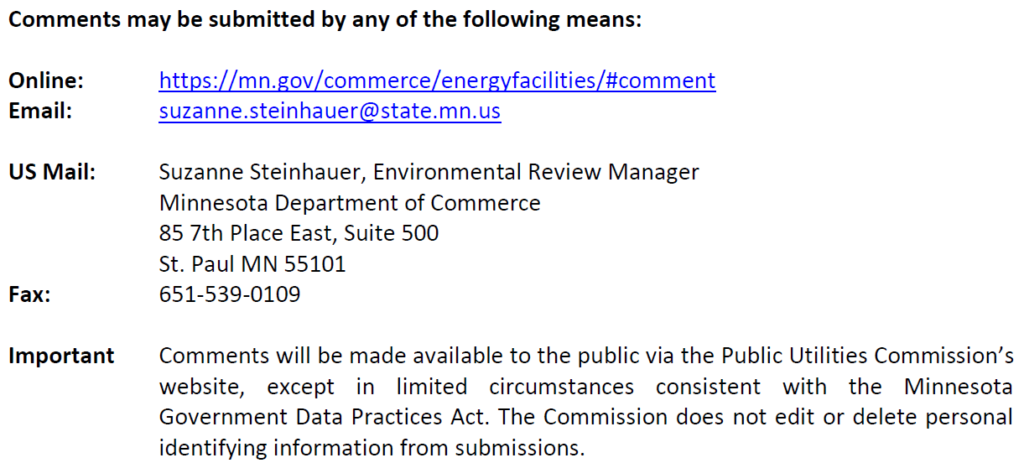Annual PPSA Hearing – November 9!
October 22nd, 2022
Just got notice of the Minnesota Public Utilities Commission‘s Power Plant Siting Act annual hearing:
This happens every year, and it’s important to spread the word around. One change that is very good is that the Commission is doing a good job of serving notice of the hearing — there are ~ 128 pages of recipients of this notice! GOOD! Love the interwebs, makes it so easy to let people know what’s happening.
The “Power Plant” aspect is very broad, this includes not just “power plants,” but transmission lines, wind projects, and solar too. This is the opportunity to tell the Public Utilities Commission, and the state generally, what works and what doesn’t work about the procedures for siting electric utility infrastructure, ideally based on your experience.
One positive aspect of COVID is that hearings are now held in “hybrid” format, both in person and online via Webex:
It is best if using Webex (http://mn.gov/puc/about-us/calendar/ and click on “November 9, 2022” to get to “webcast”) to have video on your computer and to use the phone for audio, whether listening or making comments — that’s the best way to avoid feedback (using headphones helps too). The webcast link usually goes live 10 minutes or so before the hearing starts.
What to comment about? If you’ve had experience with a Public Utilities Commission siting docket, if there were issues that made it difficult to participate, things needing clarification, rules and/or procedures that need changing, this is a way to bring it to the Commission’s attention. Over the 27 years that I’ve been dealing with utility siting issues, oh, the horror stories I can and do tell. The system needs work, and siting infrastructure is a constantly evolving process, sometimes very good changes are made, and sometimes, no matter how much we petition (formally and informally), challenge, cajole, demand, they just won’t take responsibility, won’t do their jobs, and won’t even promulgate necessary rules.
A main point of holding this hearing, as above, is hearing from “the public.”
In addition to the public participation issues exposed in this report (about which not much, not enough, has been done), a few things that I’ll be bringing up, orally or in writing:
- The Office of Legislative Auditor investigated the Public Utilities Commission‘s practices, and this report had recommendations, most of which have not been addressed:
OLA-Report_PUC Public Participation 2020
- The Public Utilities Commission has not, in the decades I’ve been participating in the PPSA Annual Hearing, EVER brought up the PPSA for discussion and ACTION on issues raised.
- Wind siting “guidelines” were adopted via Commerce-EERA without public notice or opportunity for input: Large Wind Application Guide.2
- Notice has not been provided to landowners on transmission line routes where “alternate” routes are proposed, and sometimes landowners have not discovered their land may be affected until the public hearing, very late in the process.
- Power Plant Siting Act rule revisions, due after the 2005 Power Plant Siting Act legislative changes, have not been promulgated, despite a years long process, NINE YEARS, many committee meetings, and a lot of work by a lot of people. The Public Utilities Commission just dropped it… no action… sigh… Minn. R. ch 7849 & 7850 Rulemaking? DEAD!
- Despite 2 rulemaking petitions to the Public Utilities Commission, there are no wind siting rules! The Commission refuses to promulgate wind siting rules, instead using Small Wind Standards:
There’s no end to the issues to raise.
In addition to the public hearing, comments may be submitted in writing:
Get to it! Register your experience with the Public Utilities Commission, and let them know what needs work.
Wisconsin Xmsn Application Filing Requirements
September 15th, 2022
Today, Comments were due (1:30 p.m., whew, just under the wire):
This is regarding the Wisconsin Public Service Commission’s Application Filing Requirements. To look at the docket, go HERE – DOCKET SEARCH and search for 5-AFR-100.
It looks like other than DATCP (DATCP Comments) and ATC (American Transmission Company Comments on Proposed Application Filing Requirements for Transmission Line Projects), I’m the only one filing comments.
HOW CAN THIS BE?
Oh, but wait, look at this on the notice:
Here’s the full notice:
MISO & Xcel Energy, et al.’s Dream
July 25th, 2022
I’ve been working on digging info about Xcel Energy’s proposal in May of a big honkin’ xmsn line from “Lyon County” to Sherco substation, wanted so they can retain transmission interconnection rights.
And today, this, from the MISO “July 26, 2022 Executive Update” appears in the inbox, the dream of MISO and Xcel... errrrr… “Grid North Partners” right?
Here’s the MISO Planning Committee meeting handout for May 20, 2022 meeting:
20220527 PAC Item 02a MTEP21 LRTP Report and Feedback Review PresentationPublished 05/25/2022
20220527 PAC Item 02b BALLOT MTEP21 LRTP Tranche 1 AddendumPublished 05/27/2022
20220527 PAC Item 02b MOTION MTEP21 LRTP Tranche 1 AddendumPublished 05/20/2022
20220527 PAC Item 03 CTA Update PresentationPublished 05/20/2022
20220527 PAC Item 03 Tariff Redlines for Upgrade FilingPublished 05/20/2022
For background, check out MTEP 21 (MTEP = MISO Transmission EXPANSION Plan, no secret the intent):
Good grief…
In the STrib:
Utilities plan to spend $2.2B on new power line projects in Minnesota
From the article:
DOE wants our comments on transmission “facilitation”
May 22nd, 2022
On May 12, 2022, the DOE released a “Notice of Intent and Request for Information Regarding Establishment of a Transmission Facilitation Program.” Comments are due June 13. Here’s the Federal Register publication:
https://www.govinfo.gov/content/pkg/FR-2022-05-12/pdf/2022-10137.pdf
One aspect that particularly concerns me is focus on NIETC transmission corridors, designated more than a decade ago, 2005 to be precise, and also containing a category of claimed need for “transmission across more than one state or transmission region.” That criteria would apply to almost every transmission project I’ve worked on, although most were segmented (so that the full extent of the project would not be considered or evaluated, DOH!):
What to comment on? Go to the above Federal Register link, and specific issues for comment start on page 6, “Questions for Requests for Information.” However, if you know of issues that should be considered but are not specified, have at it, put it down in detail.
I do get a little paranoid when they request comments on subjects like this — that “barriers to transmission” is one often raised by Beth Soholt, WOW (now as “Clean Grid Alliance” even more directly identifiable as transmission toadies), and here it is:
Comments are due by June 13, and should be sent to the “Federal eRulemaking Portal” (the only option), and must include the “agency name and identifier.” The agency is “Grid Deployment Office, Department of Energy.”
A decade ago or more, our state agencies eliminated consideration and scrutiny of “need” for transmission by making transmission a “regional” and market matter, making state permitting review nothing more than a rubber stamp. There’s never been a transmission proposal that state agencies didn’t love, rubber stamping everything that came their way. Now that fossil is to be shut down, that should free up immense capacity, but you’ll note that that doesn’t ever seem to be in the mix. Even NERC notes that fossil generation isn’t projected to decrease much, and locally, a good example is GRE’s walk-back on their promise to close Coal Creek, and instead “sold” the plant and transmission, and signed PPA to buy the Coal Creek generated energy.
Here’s NERC’s 2021 Long Term Reliability Assessment’s projection of MW of resources, note that coal doesn’t seem to be going anywhere anytime soon:

If shuttering down fossil is not incorporated into the transmission capacity “need,” exactly what are they basing the “need” claim on? Inquiring minds want to know.
Anyway, do check out the request for comments and let them have it. There are a many specific issues presented that has something for everyone!
Recently, I learned that the Minnesota Public Utilities Commission decided that an “informal” process was to be used in reviewing the three NextEra Dodge County Wind applications and three dockets — Certificate of Need (20-865), Wind Siting (20-866), and Transmission (20-867).
This notion that an “informal” process is appropriate is bizarre — this is exactly the sort of project that needs a contested case!. A few years ago, NextEra had applied for permits for Dodge County Wind, and that project as proposed was so unworkable that they withdrew all three of the applications:
… though for sure it was also hampered by an equally bizarre proposal by Commissioner Tuma that they run a 345kV transmission line through the backyard of homes in Dodge Center! Regular folks stood up and weighed in and stopped this massive transmission line from going through their yards (in many cases, the easement would have included their homes, and many homeowners would have been displaced!).
- Dodge Center Xmsn – Mission Accomplished!
- Dodge Center Transmission in the news
- Dodge Center 345 kV transmission?
- Xmsn through Dodge Center?
- Dodge County Wind info presentation
What are these Commissioners thinking? They’re supposed to be regulators, not enablers.
Anyway, the task at this point is to file comments before the May 25 deadline. In addition to the areas above, it’s important to request a “contested case” and request that an advisory task force be established.
NEXT STEPS:
First, the easy one — Request an advisory task force, as provided by Minn. Stat. 216E.08:
So far, the Commission has not ordered an advisory task force for wind, EVER! Commerce-EERA has always used a very narrow definition of “siting” to argue against it. However, an advisory task force is exactly what’s needed to point out environmental issues and the impacts of both micro and macro siting of the wind project and transmission, i.e., this is LARGE Wind Energy Conversion System (LWECS) sited using small wind standards (Order Establishing General Wind Permit Standards, Docket No. E, G999/M-07-1102 (MPUC 2008); are all the homes (“receptors”) identified on the map; are wetlands and flood areas shown; are the maps sufficiently detailed to show 3×5 and 5×5 rotor setbacks; are easements identified and secured by this private corporation that is not a utility; impact of blinking red lights and use of new motion detected lighting system; impacts on nearby Rice Lake State Park; transmission and distribution lines identified; are all airports there, including private airports for spraying; are all sloughs and wetlands identified; all FAA applications in application; are participating and non-participating landowners regarded equally in siting and modeling; etc.
Second TO DO, and more complicated. In your own words (cut & pasting doesn’t cut it) REQUEST a referral to the Office of Administrative Hearings for a CONTESTED CASE PROCEEDING, and explain what material issues of fact need to be addressed in a contested case. Commenters thus far have raised issues that need to be addressed, the record developed, before any decision can be made. Some clues were above, and now rehashed below:
- This is LARGE Wind Energy Conversion System (LWECS) sited using small wind standards (Order Establishing General Wind Permit Standards, Docket No. E, G999/M-07-1102 (MPUC 2008) — small wind standards are not relevant to a LWECS project;
- Most wind projects miss homes in the project footprint — are all the homes (“receptors”) identified on the map and considered in siting;
- Does the project have all land rights for wind turbines (“targeted, pending, no status, and not interested” do not count, only leased. It appears that land rights are needed for 14 turbines.
- Does the project have all land rights for transmission. This is a private company with no right of eminent domain.
- Are all wetlands, calcareous fens, sloughs, and flood areas accurately mapped and impacts considered;
- Are the maps sufficiently detailed to accurately depict the 3×5 and 5×5 rotor setbacks;
- Are impacts of blinking red lights considered;
- Is the use of new motion detected lighting system approved and is FAA applications for this system and for all turbine lighting in the application;
- What are impacts on nearby Rice Lake State Park and other state land, easements, waters;
- NextEra has been fined by USFWS and is “on probation” for killing at least 150 bald eagles. Is NextEra’s eagle survey and Avian and Bat Protection Plan sufficient;
- Are all existing transmission and distribution lines identified and considered;
- Is noise modeling predictive of ability to comply with noise standards;
- Will shadow flicker be inflicted on residents?
- Has use of storage rather than transmission been evaluated;
- Is this the highest and best use for agricultural land;
- Does utility scale central station wind fit with county and township land use plans;
- Are claims that energy generated will be used in Minnesota credible, particularly considering typical powerflows to the east and south;
- Will this project directly reduce generation of CO2;
- Are all airports identified, including private airports for spraying, and are impacts considered;
- Are the impacts, risks, and costs of the turbines on aerial crop and insect spraying, medical, and hazmat helicopter flights identified and considered;
- Are participating and non-participating landowners regarded equally in siting and modeling impacts and avoidance;
- Is there a binding road use agreement with townships and counties;
- Does the decommissioning plan sufficiently protect landowners from burden of decommissioning and cost recovery in the event of operator’s failure to decommission, bankruptcy, and/or abandonment of the project;
- etc., etc., etc.
Comments are due by 4:30 p.m. on May 25th. DON’T MISS THIS DEADLINE!!
In addition to sending in your comments using options below, I also STRONGLY ADVISE you post them in eDockets. Registration is easy and immediate, and by posting to all three dockets, others will know about issues you’re concerned with and can join in and amplify these concerns.
OK, let’s get to work — it’s time to print out those documents, the revised application, later filings of maps, etc.
To access the PUC dockets go HERE to eDockets Project Database, then search for dockets 20-865 (Certificate of Need), 20-866 (Wind Siting), and 20-867 (Transmission). Just plug “20” into the “year” space, and “865” or “866” or “867” into the “docket” space.
Subscribe to the docket to get notice of filings — subscribe by clicking on a box under the “Subscribe” column heading, then click the grey “Subscribe” button, and follow the directions:
Here are links to some of the NextEra “Dodge County Wind” docket filings:



















